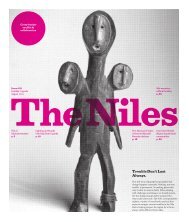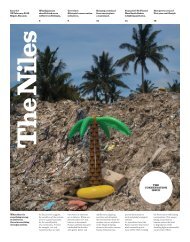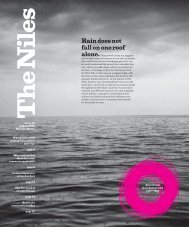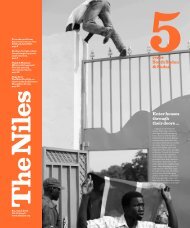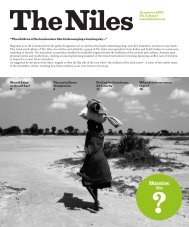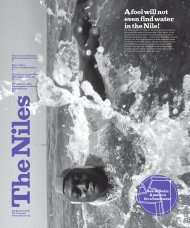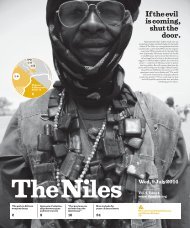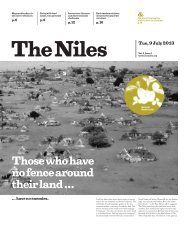You think of water when the well is empty...
Although we strive to be prepared, sometimes we can be caught unawares. That is why it’s worth thinking about water before the well goes dry in order to have enough time to plan ahead. Part of this preparation is knowing what the right questions are and striving to answer them. To be prepared and plan ahead also means to notice small changes when they occur. This can only happen if you spend time observing and learning. The Nile shows us its many facets depending on the light, the time of day and the mood of the observer. Noticing these changes helps us to know more and be prepared. Through the pages of this paper, correspondents from the Nile Basin countries share their experiences and observations about the Nile and try to find answers to the most relevant questions about the river. We celebrate the day of the Nile by thinking about water, before the well goes dry.
Although we strive to be prepared, sometimes we can be caught unawares. That is why it’s worth thinking about water before the well goes dry in order to have enough time to plan ahead. Part of this preparation is knowing what the right questions are and striving to answer them.
To be prepared and plan ahead also means to notice small changes when they occur. This can only happen if you spend time observing and learning. The Nile shows us its many facets depending on the light, the time of day and the mood of the observer. Noticing these changes helps us to know more and be prepared.
Through the pages of this paper, correspondents from the Nile Basin countries share their experiences and observations about the Nile and try to find answers to the most relevant questions about the river. We celebrate the day of the Nile by thinking about water, before the well goes dry.
You also want an ePaper? Increase the reach of your titles
YUMPU automatically turns print PDFs into web optimized ePapers that Google loves.
10 TN TN 11<br />
Fast and<br />
convenient<br />
Is <strong>the</strong> Nile still<br />
an important<br />
transport route?<br />
By Mugume Dav<strong>is</strong><br />
T<br />
From Ancient Egyptian times to today <strong>the</strong> River Nile<br />
has long helped transport people and goods.<br />
he River Nile has been used for millennia as a<br />
means <strong>of</strong> transporting people and goods, preceding<br />
even Ancient Egyptian civilization.<br />
Today it serves as both a transport route and<br />
an attraction for locals and tour<strong>is</strong>ts alike.<br />
Up until <strong>the</strong> 19th century and <strong>the</strong> arrival <strong>of</strong> <strong>the</strong><br />
steam engine, it was virtually unknown to travel<br />
for long d<strong>is</strong>tances by land. The majestic River Nile<br />
allowed people and goods to move across d<strong>is</strong>tances<br />
long and short.<br />
H<strong>is</strong>torical Egyptian <strong>water</strong>craft had a high stern<br />
and bow, equipped with cabins at both ends. The<br />
boats were propelled south by <strong>the</strong> prevailing winds,<br />
while boats heading north relied on <strong>the</strong> current<br />
and oars.<br />
The simplest type <strong>of</strong> boat in ancient Egypt was<br />
<strong>the</strong> skiff, made from tying toge<strong>the</strong>r papyrus reeds.<br />
They were used for travelling short d<strong>is</strong>tances as<br />
<strong>well</strong> as f<strong>is</strong>hing and hunting game in <strong>the</strong> marshes.<br />
Longer journeys were taken on large wooden<br />
ships, which were equipped with square sails<br />
and oars. They were made <strong>of</strong> wooden planks, held<br />
toge<strong>the</strong>r with rope, which expanded in <strong>the</strong> <strong>water</strong>,<br />
making <strong>the</strong> ship <strong>water</strong>tight. The ships were used<br />
to transport <strong>the</strong> massive blocks <strong>of</strong> stone that were<br />
used to build <strong>the</strong> pyramids, temples and cities along<br />
<strong>the</strong> river.<br />
The only reliable means <strong>of</strong> transport<br />
port, travelling frequently from <strong>the</strong> town <strong>of</strong> Jinja<br />
to Uganda’s capital Kampala.<br />
“It <strong>is</strong> a great experience and I do it at least once<br />
a month,” Lek says, adding that he pays 1,000 Ugandan<br />
shillings for <strong>the</strong> trip.<br />
For o<strong>the</strong>rs, travelling on <strong>the</strong> Nile <strong>is</strong> purely a source<br />
<strong>of</strong> pleasure.<br />
Ringo Ringo Garang, for example, <strong>is</strong> an IT<br />
special<strong>is</strong>t from South Sudan who <strong>of</strong>ten takes cru<strong>is</strong>es<br />
to floating <strong>is</strong>lands on <strong>the</strong> river. “It always gives me<br />
peace <strong>of</strong> mind <strong>when</strong>ever I cru<strong>is</strong>e on <strong>the</strong> River Nile,”<br />
he says.<br />
A business opportunity<br />
The river can also be a source <strong>of</strong> income to<br />
entrepreneurs. W<strong>is</strong>wa Mukuve, for example, has<br />
taken advantage <strong>of</strong> <strong>the</strong> business opportunities<br />
<strong>the</strong> River Nile <strong>of</strong>fers.<br />
The 37-year-old, who set up h<strong>is</strong> own business<br />
in 1999, sells small boats and canoes to f<strong>is</strong>hermen<br />
and rents out boats for pleasure trips for 10,000<br />
Ugandan shillings a day.<br />
He also transports passengers and commodities<br />
ei<strong>the</strong>r on <strong>the</strong> River Nile or Lake Victoria from Masese<br />
port, about 1.5 kilometers from Jinja.<br />
Mukuve says he makes a daily pr<strong>of</strong>it <strong>of</strong> 30,000-<br />
40,000 Uganda shillings, despite <strong>the</strong> challenges <strong>of</strong><br />
high fuel prices. He supports h<strong>is</strong> family <strong>of</strong> two wives<br />
and 10 children, who all go to school. “I have managed<br />
to buy a plot <strong>of</strong> land and I am now building on it.”<br />
To th<strong>is</strong><br />
day <strong>the</strong><br />
river <strong>is</strong><br />
still a fast<br />
and convenient<br />
means <strong>of</strong><br />
transport.<br />
Transporting people and goods<br />
on <strong>the</strong> Nile <strong>is</strong> an important source<br />
<strong>of</strong> income for many entrepreneurs<br />
living along <strong>the</strong> river.<br />
The Niles / Mugume Dav<strong>is</strong><br />
The vessels may have become more modern,<br />
but to th<strong>is</strong> day <strong>the</strong> river <strong>is</strong> still a fast and convenient<br />
means <strong>of</strong> transport for <strong>the</strong> millions <strong>of</strong> people<br />
living in <strong>the</strong> Nile River Basin countries, such<br />
as Uganda.<br />
One <strong>of</strong> <strong>the</strong>se <strong>is</strong> Elizabeth Kiden, who lives<br />
in Koboko, Nor<strong>the</strong>rn Uganda. She <strong>of</strong>ten v<strong>is</strong>its her<br />
relatives who live on <strong>the</strong> o<strong>the</strong>r side <strong>of</strong> <strong>the</strong> river<br />
in Adjumani. Although it only takes 15 minutes<br />
to cross <strong>the</strong> Nile by ferry, <strong>the</strong> first time she made<br />
<strong>the</strong> trip she was worried.<br />
“I was scared because <strong>of</strong> <strong>the</strong> large <strong>water</strong> and I<br />
imagined <strong>the</strong>re were animals in <strong>the</strong> <strong>water</strong>,” she says.<br />
“But in <strong>the</strong> end it was fun.”<br />
Lek Lek who hails from <strong>the</strong> Eastern Ugandan<br />
d<strong>is</strong>trict <strong>of</strong> Jinja also depends on <strong>the</strong> river for trans-<br />
8 things you didn’t know about <strong>the</strong> Nile<br />
2. 3.<br />
How many Nubians were d<strong>is</strong>placed by <strong>the</strong> construction<br />
<strong>of</strong> <strong>the</strong> Aswan High Dam?<br />
According to <strong>the</strong> organization International Rivers, 90,000 Nubians<br />
who once occupied <strong>the</strong> area surrounding <strong>the</strong> Aswan Dam had to be relocated<br />
due to <strong>the</strong> flooding caused by <strong>the</strong> construction <strong>of</strong> <strong>the</strong> dam in <strong>the</strong> 1960s. The<br />
farmers who live in <strong>the</strong> area today have to purchase costly artificial fertilizers<br />
because <strong>the</strong> nutrient-rich silt that used to be naturally deposited on <strong>the</strong><br />
farming lands <strong>the</strong>re <strong>is</strong> now trapped behind <strong>the</strong> Aswan Dam.<br />
Is <strong>the</strong> Nile known by any o<strong>the</strong>r name?<br />
Although “River Nile” <strong>is</strong> <strong>the</strong> most famous name, known around<br />
<strong>the</strong> world, <strong>the</strong> river actually has a different name in almost every<br />
region it flows through. In Sudan, <strong>the</strong> river <strong>is</strong> known as Bahr al Ghazal,<br />
but <strong>the</strong> sou<strong>the</strong>rn tributary <strong>of</strong> <strong>the</strong> river <strong>is</strong> called Bahr el Abyad. In o<strong>the</strong>r parts<br />
<strong>of</strong> Sudan and South Sudan, it <strong>is</strong> known as <strong>the</strong> White Nile and <strong>the</strong> Blue Nile.<br />
When it enters Ethiopia, it <strong>is</strong> referred to as Bahr el Jabal. But as it flows<br />
deeper into <strong>the</strong> country, it becomes Sobat. O<strong>the</strong>r tributaries <strong>of</strong> th<strong>is</strong> mighty<br />
<strong>water</strong> have several names, including <strong>the</strong> Yellow Nile, Atbara, and Aur.




